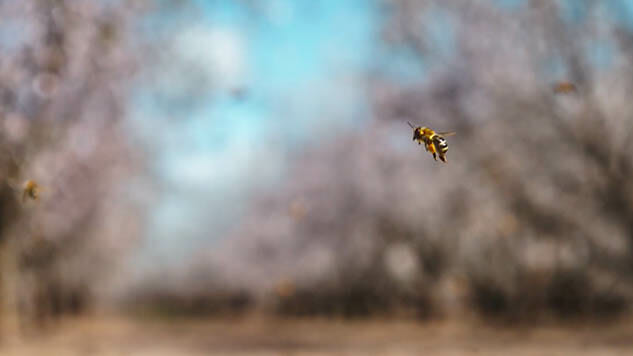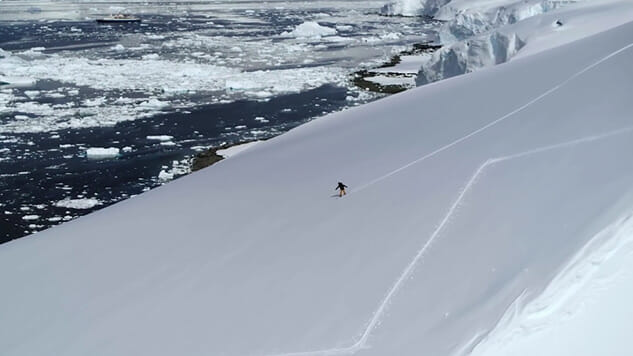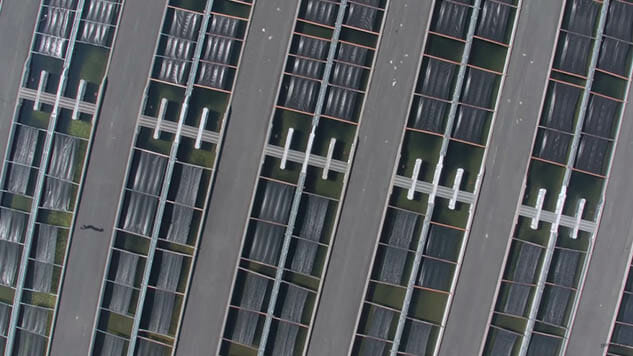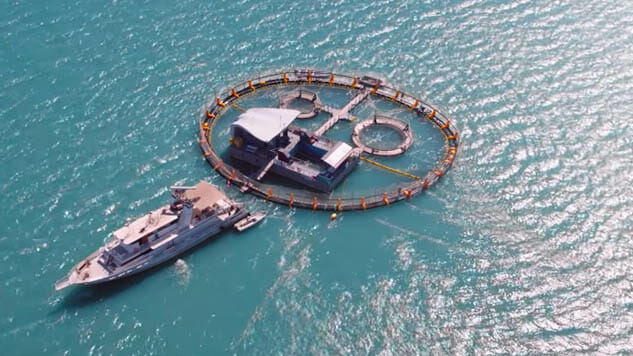Tuning out Existential Angst at Tahoe Film Fest
Surrounded by the majesty of nature, Dom watched a bunch of depressing documentaries about how screwed nature really is.
Movies Features Tahoe Film Fest
If one were predisposed to a cynical take on pretty much everything, there’s a bitter sense of irony to the Tahoe Film Fest. In its fifth year, the festival featured both high-profile Netflix premieres—Marriage Story and The Two Popes bookending the weekend—and a special screening of Roland Emmerich’s Midway, starring everyone’s favorite Ocean Master, Patrick Wilson.
Speaking of mastering the oceans, though, the real thematic heft of TFF could be found in its breadth of environmental documentaries. High in the Sierra Nevadas, it’s hard to avoid the cognitive dissonance in experiencing a host of movies laying out just how irrevocably doomed our rotten wasteland of a planet is when you wake up the next morning to some cartoonishly picturesque snowfall.
Headed by Executive Director Robert Roussel—co-founder of the Puerto Vallarta International Film Festival with Anjelica Houston, he’s a man who will gladly tell you one story after another about all his time working with George Roy Hill, Roger Corman and Robert Wise, amongst a trophy case of legends—Tahoe Film Fest takes on a number of purposes for the Lake Tahoe community. It brings in small, niche films that wouldn’t otherwise make it to the area, and it gives some welcome public-facing happenings to the much thinner population of inhabitants sticking around during the off-season. But most of all, Tahoe Film Fest provides beautiful context for a town that takes its sustainability seriously.

Following opening night’s Marriage Story was Casper Mazzotti’s briskly hour-long Out of Bounds: An Epic Mountain Journey, part snowboarding travelogue and part PSA for environmental stewardship, brought to you by Honda. An unceasingly pretty movie meant for taking your grandkids to at the local IMAX theater on a Saturday, Out of Bounds follows Olympic snowboarder Torah Bright as she travels all over the world—from Antarctica to Arctic Alaska—“working,” according to the press materials, “with her team to understand and protect these epic ecosystems from an ever-changing world.”
Which is stretching the flick’s purview quite an unfair bit, especially when Out of Bounds is mostly a lot of shots of Bright and her world class peers doing insane stunts down terrain on which no human’s set foot or board before. We’re not offered much more in the way of actual direct action or compelling science; when we’re told that Bright and her team are attempting to “understand” the ecosystems photographed with such reverence, we’re left to watch them epically stare off into the horizon after some especially crispy runs, to wonder what noble pursuits they must be planning in their heads having experienced Mother Nature at her most primal. They are no doubt understanding their hearts out. If only we could join them.
Out of Bounds was shown at the Crystal Bay Casino, a still-humming old Rat Pack haunt on the California-Nevada border, where bartenders and hosts are brimming with stories about Poison shooting a music video there, or Coppola filming The Godfather there, or Sinatra throwing assorted items across the dining room there. A 13,000-year-old Wooly Mammoth’s tusk rests on the bar in the Steakhouse, casting an imposing shadow over one’s lobster tail, the ancient tooth mounted in the corner for no other reason than because it can be, because it exists. The owner apparently bought two. The lobster was good because it couldn’t not be.
Signs of wealth and excess limn everything that happens in Tahoe, make up so much of its legacy and history, but plenty of locals stay engaged in political action, promoting Lake Tahoe as a community that can thrive not despite, but because of, all of its resources. Jeremy Jones, a professional snowboarder who still lives in the area, introduced Out of Bounds, popping up in the film during Bright’s Alaskan leg. Knowing some of us might intuit the the film’s lack of actionable content, he began with a simple statement (“Life is precious. We live in a beautiful place.”), a reminder to drink local tap water, and some impassioned explanation for for his non-profit, Protect Our Winters, which does a lot of work with both local and State-wide politicians and educational/conservation groups to advocate for systemic change.

Much of the films featured at TFF bore the same frustration and sense of helplessness, about species and ecosystems and even people dying in the shadow of mass-market, institutional decimation. Accordingly, Matt Wechsler and Annie Speicher introduced their documentary, Right to Harm, to an audience already primed for a cinematic bummer. The film wisely tackles the threat of Concentrated Animal Feeding Operations (CAFOs)—typically industrial hog farms producing millions of gallons of animal waste, often untreated, that annihilates the quality of life of nearby residents—from the perspective of those who must endure it, every single day, socioeconomically unable to do anything but stay in their family house downwind of exhaust fans pumping out wave after wave of bacterial shit air, or unwilling to leave behind the neighborhood in which their family has lived for generations, despite the recent presence of a waste sprayfield and lagoon across the street. Like many of the sleekly dire documentaries found at TFF, Right to Harm coasts too easily on virtue signalling and HD drone shots and the occasional Erik Satie ditty to infuse the film with unearned gravitas, but once we’ve been introduced to the plights of rural West Virginia, Wisconsin and Arizona, Wechsler and Speicher invaluably reorient their film toward the direct political action of the most outspoken in these communities. Though the EPA and State politicians openly flaunt their spineless susceptibility to lobbying dollars and/or dejectedly admit that they’ve been federally deregulated into obsolescence, the film focuses most saliently on the local activists who continue to show up no matter how little power they’re constantly reminded they have.
In more dramatic terms, Richard Levien’s Collisions addresses the abusive state of immigration in America through a Bay Area Mexican family reduced to chattel, lost in our fundamentally dysfunctional system. One day, Itan (Izabella Alvarez) comes home with her younger brother Neto (Jason Garcia Jr.) to find their mother (Ana de la Reguera) gone, their apartment raided by ICE. Seeking help from their estranged uncle Evencio (Jesse Garcia), a man who’s seen his share of holding cells, Itan follows their mother throughout the West as she’s first transferred from unmarked locale to unmarked locale and then, finally, back to Mexico. Levien’s grasp on Evencio’s trauma feels mostly obligatory, but the director’s knack for laying out the Moebius strips of bureaucracy that prevent Itan from making her way back to her mother contributes to a constant tone of throttled progress. Why wouldn’t Itan just give up when the system is, by its very nature, bent on breaking her?

Where does anybody get that kind of strength? Especially when so much of what we think we’re doing to help only accelerates the inevitable. Josh Murphy’s Artifishal speaks with government scientists, corporate fishermen, tribal ecologists and even Patagonia co-founder Yvon Chouinard to create a dire portrait of the health of our wild fish populations and habitats throughout North America. In examining how fish hatcheries and farms, intended to preserve populations threatened by dams and human infrastructure, actually poison the sustainability of our watersheds, the film castigates us for ever entertaining the thought that we know better. Amidst cursory glimpses of fish breeding operations—egg sputum squeezed out of salmon like toothpaste from a tube—at one point, Artifishal tells of the long-gestating, forever-controversial Klamath Dam project to remove four hydroelectric dams in southern Oregon and northern California. Though the facilities have been proven to not preserve salmon populations, to actually do the opposite of what they’re supposed to do, the entities involved in the $434 million project—such as PacifiCorp, the Federal Energy Regulatory Commission, and the combined forces of Senators Kamala Harris and Jeff Merkley—will move forward with plans for more, new fish hatcheries. We are broken, but we insist on breaking further.
Sea of Shadows, directed by Richard Ladkani—produced by Leonardo DiCaprio with an assist by National Geographic—mounts an international thriller around the vaquina, a whale native to the Sea of Cortez on the brink of extinction. Only 15 or so left in the world, the vaquina share a habitat with the totoaba fish, harvested by Mexican cartels, the Chinese mafia and a lot of desperate people looking to sell their swim bladders on the black market. As one might assume, the vaquina are collateral, caught in the countless nets left cut and discarded all over the sea. Like Cartel Land, Sea of Shadows profiles many sides of the animal’s fate, from the fishermen who fall under the control of local cartels just trying to support their families, to the famous journalist confronting corruption in the Mexican government, to the coalition of radical environmentalists who spend their nights chasing away fishermen with drones, locating the nets and freeing whatever tangled wildlife has managed to stay alive.
The film builds unbearable tension from simply making plain how little chance the vaquina has to survive. But unbearable bleakness doesn’t make an appearance until a coalition of international marine biologists, supported by the Mexican government, builds a habitat in the Sea of Cortez, hoping to relocate the remaining vaquina, having little idea of what else to do. Sea of Shadows joins the scientists as they locate and then carefully capture a female vaquina—the first time many of these people have even seen one—successfully introducing her into their new habitat. Until she stops breathing, and the bottom falls out from underneath the film, the reality of the immense failure that even the best minds with the most noble intentions must accept. Though Ladkani insists on concluding with a semblance of hope—the pulpier side of his narrative ringing with a Vice News kind of sexy danger—there’s no coming back from such total and absolute loss. The movie is most likely on Disney+ right now.

Really, you spend barely a day in Lake Tahoe, and the overwhelming impossibility of living a moral modern life saturates every moment. I walked outside of my hotel one morning to discover a line of fire and emergency vehicles flanking the whole of the front entrance. I assumed the worst, as you do, until I realized they were all attached to long plugs, charging up for the day. I admired the symbiotic community spirit, resorts working with local social services to keep Lake Tahoe clean. Back inside, plenty of signs explained how to conserve water and electricity in one’s hotel room. Across the road was a sandwich shop with a mostly vegan menu. At the far end of the parking lot were Tesla charging stations aplenty. I was told that there are a lot of Teslas around. I was often told things that equally delighted and depressed me.
Same went with what I watched. The Pollinators, Peter Nelson’s survey of the North American honeybee’s decline, has more positivity to promote than one might expect. Not that the situation isn’t critical—we are, as most of these films can attest to, pretty fucked—but Nelson quickly moves from explication to action, talking to progressive farmers and environmental scientists about the many ways they’ve successfully developed farms that require very little chemicals and foster their own thriving pollinator populations. It was nice to see someone smile for once in these movies.
Probably the best part about the Tahoe Film Fest is the involvement of the UC Davis Tahoe Environmental Research Center. More than directly benefiting from all of the fest’s proceeds, TERC was an active partner, curating many of the films shown. Behind the higher-profile awards bait was the desire to translate the sustainably minded essence of Lake Tahoe into something more engaged with environmental efforts all over the world.
This was perhaps most obvious in Honeyland. With great warmth and reverence, Tamara Kotevska and Ljubo Stefanov’s film mourns a fading way of life—a way through which we’re introduced to Hatidzhe, whose whole life resonates, on some primordial level, with beekeeping. She climbs steep heights and navigates narrow ledges of rural Macedonia until she brings us to a honeybee colony she’s discovered deep in the face of a mountainside. She takes a few combs, carefully wraps them for the slow journey home. She lives without electricity in a village all but abandoned were it not for her bedridden mother, whose head’s half-wrapped with a scarf to hide a wound or large sore, it’s not clear, whose only company when Hatidzhe walks to town to sell jars of honey are the flies she attracts. Hatidzhe tends to her bees—only taking “half” the honey, leaving the rest for the burgeoning colony—in the ruins of what might have once been a thriving town, and her mother sleeps, occasionally rising to eat honey, or a banana, just a little. This is how their days pass, until a big family of neighbors rolls up with a camper, some cattle and a desperate ambition to make something out of all that land.
Though she may be too gregarious and giving for her own good, Hatidzhe welcomes the company, even if the family’s patriarch, Hussein, can be an abusive blowhard. Even if he gets a touch too curious about Hatidzhe’s talent with bees, squeezing her for secrets. Even when he starts his own beekeeping operation, but has nothing of Hatidzhe’s respect or patience or preternatural connection to the insects. Even when his hives ruin hers. Devoid of voiceover or chyrons describing location or anyone’s name—told only through a language most English-speakers admittedly wouldn’t recognize and a bed of sound on which rests a beautifully remote, mountainous ecosystem—Hatidzhe’s story quietly unfolds. There’s not much she can do as Hussein co-opts her calling, especially when Hussein’s investor insists he drive his hives into the ground to reap “enough” honey. One can easily catch metaphors about mass-market industrialization, or conjure up less material parables about humans’ insatiable urge to annihilate everything in their paths. Honeyland resists the tendency to sprawl out. Instead, Hatidzhe must accept what’s happened and move on. We do the same. Which is a lot easier to do when you’re in Lake Tahoe, at least.
Deepest thanks to everyone involved with Tahoe Film Fest, for all the hospitality I was shown, all the good beer I drank at Alibi Ale House, and all the fascinating stuff I saw at Gatekeeper’s Museum in Tahoe City, the only combination Native American/1960 Squaw Valley Olympics/Skiing History museum I’ve ever had the pleasure of slowly walking through.
Dom Sinacola is Associate Movies Editor at Paste and a Portland-based writer. You can follow him on Twitter.